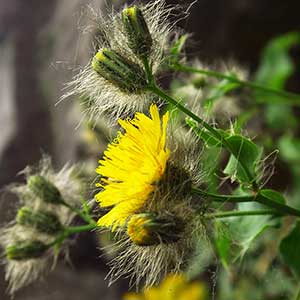Hieracium longiberbe
Hieracium gronovii
long-bearded hawkweed, longbeard hawkweed
beak hawkweed, gronovis hawkweed, queendevil
proximally piloso-hirsute (hairs 2–8+ mm), sometimes glabrate, distally glabrous or piloso-hirsute (hairs 2–5+ mm).
proximally piloso-hirsute (hairs 2–4+ mm), sometimes stellate-pubescent as well, distally stellate-pubescent, sometimes piloso-hirsute as well.
basal 0(–3+), cauline 6–12+;
blades spatulate to oblanceolate, 25–80(–100+) × 8–15(–25+) mm, lengths 3–5 times widths, bases ± cuneate, margins usually entire, rarely denticulate, apices obtuse to acute, abaxial faces piloso-hirsute (hairs 2–5+ mm), adaxial usually piloso-hirsute at margins (hairs 2–5+ mm), rarely glabrous.
basal 0(–2+), cauline (3–)6–12+;
blades elliptic or obovate to oblanceolate, 20–35(–90) × 10–40(–50) mm, lengths 2–4+ times widths, bases cuneate to rounded (sometimes ± clasping), margins entire, apices rounded to acute, abaxial faces piloso-hirsute (hairs 2–4 mm) and stellate-pubescent, adaxial piloso-hirsute.
usually stellate-pubescent, sometimes piloso-hirsute and/or stipitate-glandular as well, rarely glabrous.
stellate-pubescent and stipitate-glandular.
campanulate, 7–10 mm.
cylindric to campanulate, 7–10 mm.
12–24+;
corollas yellow, 7–12 mm.
12–20+;
corollas yellow, 8–9+ mm.
12–15+, apices ± rounded, abaxial faces piloso-hirsute and stellate-pubescent.
12–15+, apices rounded to acute or acuminate, abaxial faces glabrous or stellate-pubescent, rarely stipitate-glandular as well.
bractlets 9–13+.
bractlets 8–12+.
(3–)6–12+ in corymbiform arrays.
(5–)25–50 in usually narrow, thyrsiform arrays (lengths of arrays usually 3–6+ times diams., sometimes shorter).
columnar, ca. 3.5 mm;
pappi of 32–40+, white or stramineous bristles in ± 2 series, 5–6 mm.
urceolate, 3.5–4.5+ mm;
pappi of ca. 40+, stramineous bristles in 2+ series, ca. 5 mm.
Hieracium longiberbe
Hieracium gronovii
Hieracium longiberbe is known only from along the Columbia River.
(Discussion copyrighted by Flora of North America; reprinted with permission.)


